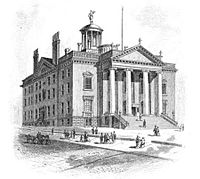53rd New York State Legislature
| 53rd New York State Legislature | |||||
|---|---|---|---|---|---|
|
|||||

The Old State Capitol (1879)
|
|||||
| Overview | |||||
| Jurisdiction | New York, United States | ||||
| Term | January 1 – December 31, 1830 | ||||
| Senate | |||||
| Members | 32 | ||||
| Temporary President | William M. Oliver (J) | ||||
| Party control | Jacksonian | ||||
| Assembly | |||||
| Members | 128 | ||||
| Speaker | Erastus Root (J) | ||||
| Party control | Jacksonian | ||||
| Sessions | |||||
|
|||||
| 1st | January 5 – April 20, 1830 |
|---|
The 53rd New York State Legislature, consisting of the New York State Senate and the New York State Assembly, met from January 5 to April 20, 1830, during the second year of Enos T. Throop's governorship, in Albany.
Under the provisions of the New York Constitution of 1821, 32 Senators were elected on general tickets in eight senatorial districts for four-year terms. They were divided into four classes, and every year eight Senate seats came up for election. Assemblymen were elected countywide on general tickets to a one-year term, the whole Assembly being renewed annually.
State Senator Robert Bogardus resigned on May 4, 1829, leaving a vacancy in the First District.
At this time, there were three political parties: the "Jacksonians" (supporting President Andrew Jackson; led by U.S. Secretary of State Martin Van Buren), the "Anti-Jacksonians" (the former supporters of John Quincy Adams, opposing Jackson and the Albany Regency), and the "Anti-Masons". In New York City, a Workingmen's Party appeared, and polled a large number of votes, winning a seat in the Assembly. In 1830, the Anti-Jacksonians re-organized as the National Republican Party (supporting Henry Clay for the presidency).
The state election was held from November 2 to 4, 1829. Alpheus Sherman, Jonathan S. Conklin (both 1st D.), Nathaniel P. Tallmadge (2nd D.), William Dietz (3rd D.), Isaac Gere (4th D.), Alvin Bronson (5th D.), Levi Beardsley (6th D.), Albert H. Tracy (8th D.) and Assemblyman Thomas Armstrong (7th D.) were elected to the Senate. Tracy was an Anti-Mason; the other eight were Jacksonians.
...
Wikipedia
